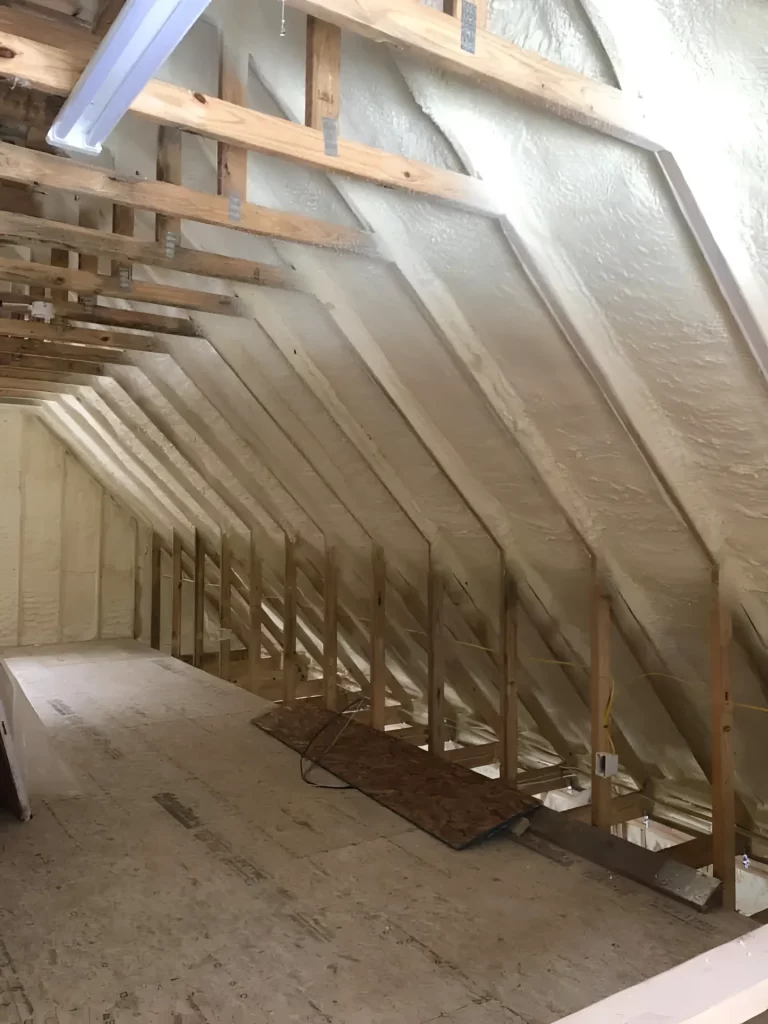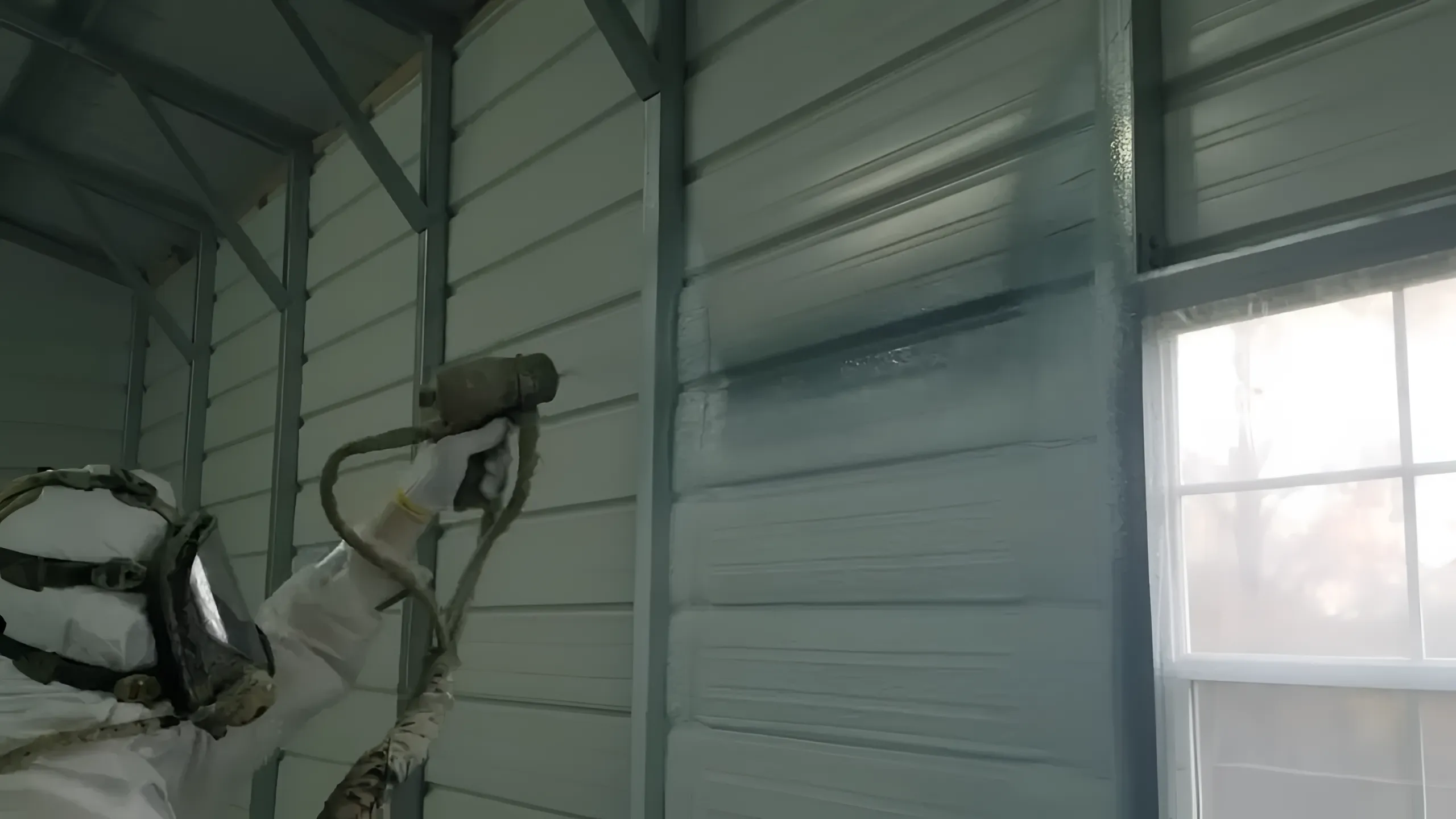Spray foam insulation stops ice dams by creating a tight seal that blocks air leaks and controls heat loss from inside the home. Ice dams form when warm air escapes through the roof and melts snow, which then refreezes at the eaves. This spray foam acts as a continuous barrier in attics and walls, keeping indoor heat contained and preventing that unwanted warming of the roof surface. Homeowners in colder areas see fewer ice dams with this approach because the insulation maintains even temperatures.
In this guide, we’ll break down the process step by step and cover practical steps for homeowners. It draws from years of handling insulation projects in regions like North Carolina, where winter weather mixes rain and occasional freezes to create tricky conditions for roofs.
What Causes Ice Dams
Ice dams start with uneven roof temperatures during winter. Snow accumulates on the roof, but heat from the home escapes through gaps in the attic. This meltwater runs down the slope and hits colder edges, where it freezes into heavy ice ridges. Those ridges trap more water behind them, leading to leaks inside the home.
Attics often lack proper ventilation or sealing, which worsens the problem. While ice dams appear less often in milder climates like North Carolina than in northern states, they can still happen after heavy rains followed by cold snaps. Data from the Insurance Institute for Business & Home Safety shows that ice dams cause about 10% of winter roof claims in southern states with variable weather.
How Spray Foam Insulation Addresses the Problem
Spray foam expands to fill every crack and crevice, forming an airtight and watertight layer. Unlike fiberglass batts, it sticks directly to surfaces and doesn’t shift over time. This setup keeps heat from rising into the attic, so the roof stays cold enough to let snow sit without melting.
Closed-cell spray foam, in particular, offers high R-value per inch, meaning it insulates more effectively in thinner layers. A study by the U.S. Department of Energy notes that spray foam can reduce air leakage by up to 75% compared to traditional insulation, directly cutting down heat transfer to the roof.
In practice, applying spray foam to the attic floor creates a thermal break. Warm air stays below, and cold air rules the attic space. This balance prevents the temperature swings that trigger ice dams.
Bonus Tip from Experience
From our hands-on projects, we recommend checking for existing air leaks around recessed lights or chimneys before insulation. Sealing those spots first ensures the spray foam performs at its best and avoids future callbacks.
Benefits of Spray Foam for Roof Protection
Spray foam not only fights ice dams but also improves overall energy efficiency. It reduces drafts that pull warm air upward, lowering heating bills in winter. For roofs, this means less stress from freeze-thaw cycles, extending shingle life.
Market data indicates that homes with spray foam insulation experience 20-30% fewer moisture-related issues, according to a report from the Building Science Corporation. In areas prone to humidity like the Southeast, this added moisture barrier helps prevent mold growth under the roof.
Another advantage comes in ventilation. Spray foam allows for balanced airflow without compromising the seal. Proper ridge and soffit vents work alongside it to keep the attic dry.
Comparison of Insulation Types for Ice Dam Prevention
Different insulation materials handle heat control in unique ways. The table below compares spray foam to common alternatives based on key factors for preventing ice dams.
| Insulation Type | R-Value per Inch | Air Sealing Ability | Moisture Resistance | Cost per Square Foot |
|---|---|---|---|---|
| Spray Foam (Closed-Cell) | 6.5-7.0 | Excellent (fills gaps) | High (waterproof) | $1.50-$3.00 |
| Fiberglass Batts | 3.1-4.3 | Poor (needs separate sealing) | Low (absorbs moisture) | $0.50-$1.50 |
| Cellulose Blown-In | 3.2-3.8 | Moderate (settles over time) | Moderate (treatments help) | $0.80-$2.00 |
| Rigid Foam Boards | 4.0-5.0 | Good (but requires taping) | High (closed-cell varieties) | $1.00-$2.50 |
This comparison highlights why spray foam stands out for comprehensive protection. It combines high insulation with built-in sealing, making it a strong choice for attic applications.
Things to Consider Before Making a Decision
Assess the home’s current setup first. Older roofs might need repairs before adding insulation to avoid trapping moisture. Measure attic space to calculate material needs accurately.
Climate plays a role too. In North Carolina’s mild winters, focus on rain-snow mixes rather than deep freezes. Budget for professional installation, as spray foam requires specialized equipment.
Energy audits reveal hidden leaks. Conduct one to see if the attic demands immediate attention. Long-term savings on energy often offset upfront costs within a few years.
Bonus Tip from Experience
From practical experience in our installations, opt for closed-cell foam in humid regions. It resists water better and maintains structure even if minor leaks occur during storms.
Common Questions
Does spray foam work on sloped roofs?
Yes, it installs directly on the underside of the roof deck, providing strong contact and enhanced protection against heat loss and air leaks.
Can spray foam insulation be removed?
It is considered permanent. While removal is possible, it’s difficult and costly, so careful planning before installation is recommended.

Frequently Asked Questions
Can spray foam insulation fix an existing ice dam?
Spray foam prevents future dams but won’t remove ice already formed. Clear the ice manually or with heat cables first, then insulate. This two-step process stops recurrence.
How long does spray foam last in preventing ice dams?
It endures for the home’s life if installed correctly. Unlike loose-fill options, it doesn’t settle or degrade quickly, providing steady performance over decades.
Is spray foam safe for homes with radiant barriers?
Yes, it pairs well with radiant barriers. The foam handles conduction and convection, while the barrier reflects radiant heat, creating layered defense against roof warming.
Does adding spray foam require attic access?
Full access simplifies the job, but pros can work around obstacles. Expect some disruption, but the result yields a more comfortable, dam-free home.
What if my attic has HVAC ducts?
Seal around ducts before foaming. This keeps conditioned air in place and boosts overall system efficiency, tying into ice dam prevention.
Key Takeaways on Ice Dam Prevention
Spray foam insulation tackles ice dams at the source by sealing heat loss and maintaining cold roof surfaces. Combine it with good ventilation for best results. Evaluate the home’s age, climate, and current insulation to decide next steps. Consider local weather patterns and energy goals to ensure long-term benefits.
Next Steps for Homeowners
Review attic conditions and consult local experts for assessments. Raleigh Excel Spray Foam Insulation offers guidance at [email protected] or (919) 301-9435. Take time to gather quotes and understand options before proceeding. This preparation leads to effective, lasting solutions tailored to specific needs.
Sources
- Insurance Institute for Business & Home Safety – Provides data on winter roof damage claims, including ice dams in variable climates.
- U.S. Department of Energy – Offers research on insulation performance and air leakage reduction with spray foam.
- Building Science Corporation – Reports on moisture issues and energy efficiency in insulated homes.




